Corporate Accounting: Surfstitch Financial Performance Analysis Report
VerifiedAdded on 2019/11/08
|12
|2994
|171
Report
AI Summary
This corporate accounting report examines the financial performance of Surfstitch, focusing on the challenges faced in 2016, including significant losses and declines in profitability. The report analyzes key financial aspects such as goodwill, intangible assets, investment in subsidiaries, cash position, and selling/distribution expenses. It also delves into the interpretation of financial statements, highlighting the decline in current and total assets, and the increase in liabilities. Part II of the report focuses on the importance of continuous reporting regimes for disclosure entities, emphasizing their role in maximizing investor confidence and market efficiency. The literature review explores the continuous disclosure obligations in the Australian financial system, the benefits of continuous reporting over selective disclosure, and the enforcement mechanisms in place to ensure compliance. The report concludes that continuous reporting is essential for protecting investors, maintaining market integrity, and enhancing a company's goodwill. The report includes a detailed analysis of Surfstitch's financial performance and the impact of continuous reporting on its operations.
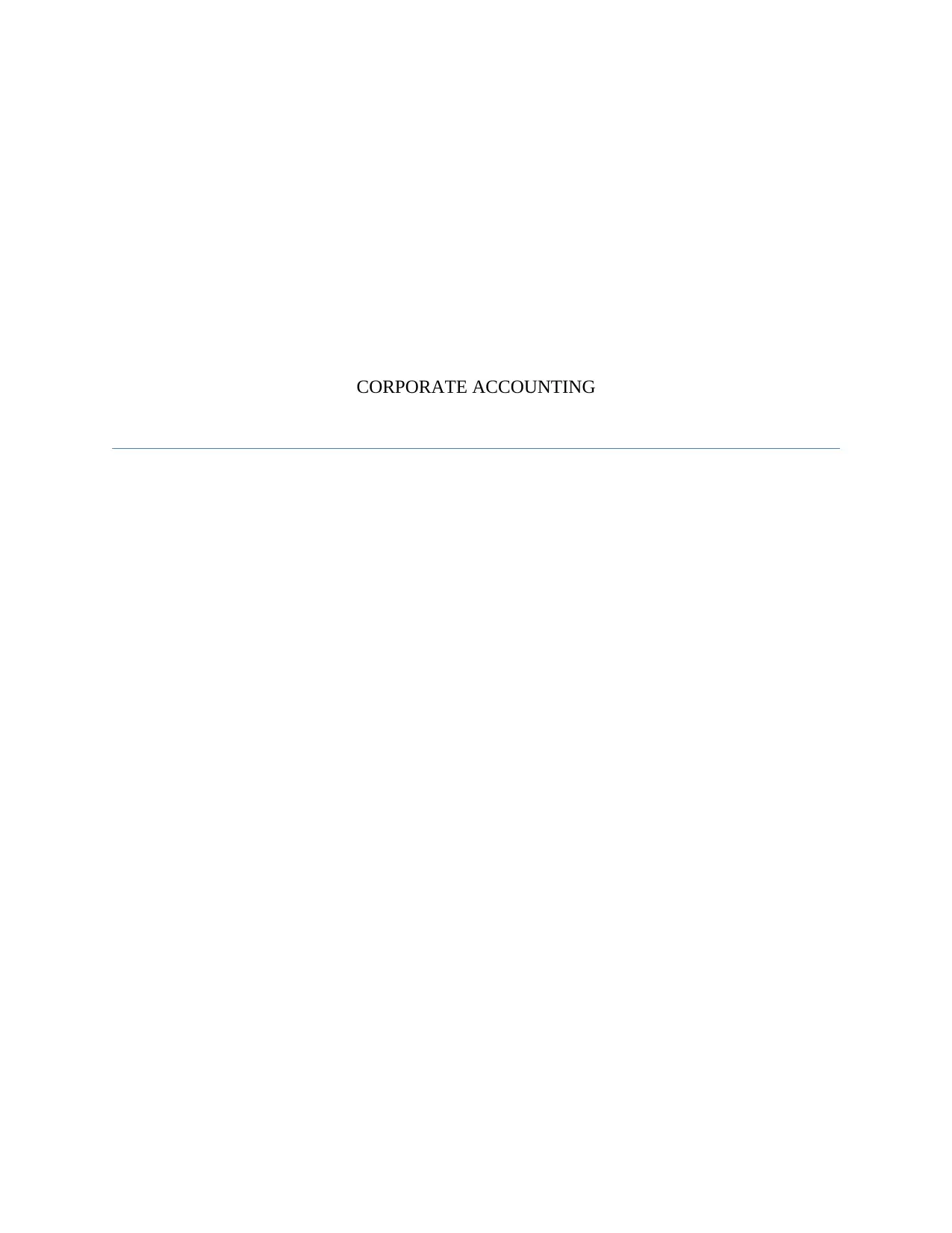
CORPORATE ACCOUNTING
Paraphrase This Document
Need a fresh take? Get an instant paraphrase of this document with our AI Paraphraser
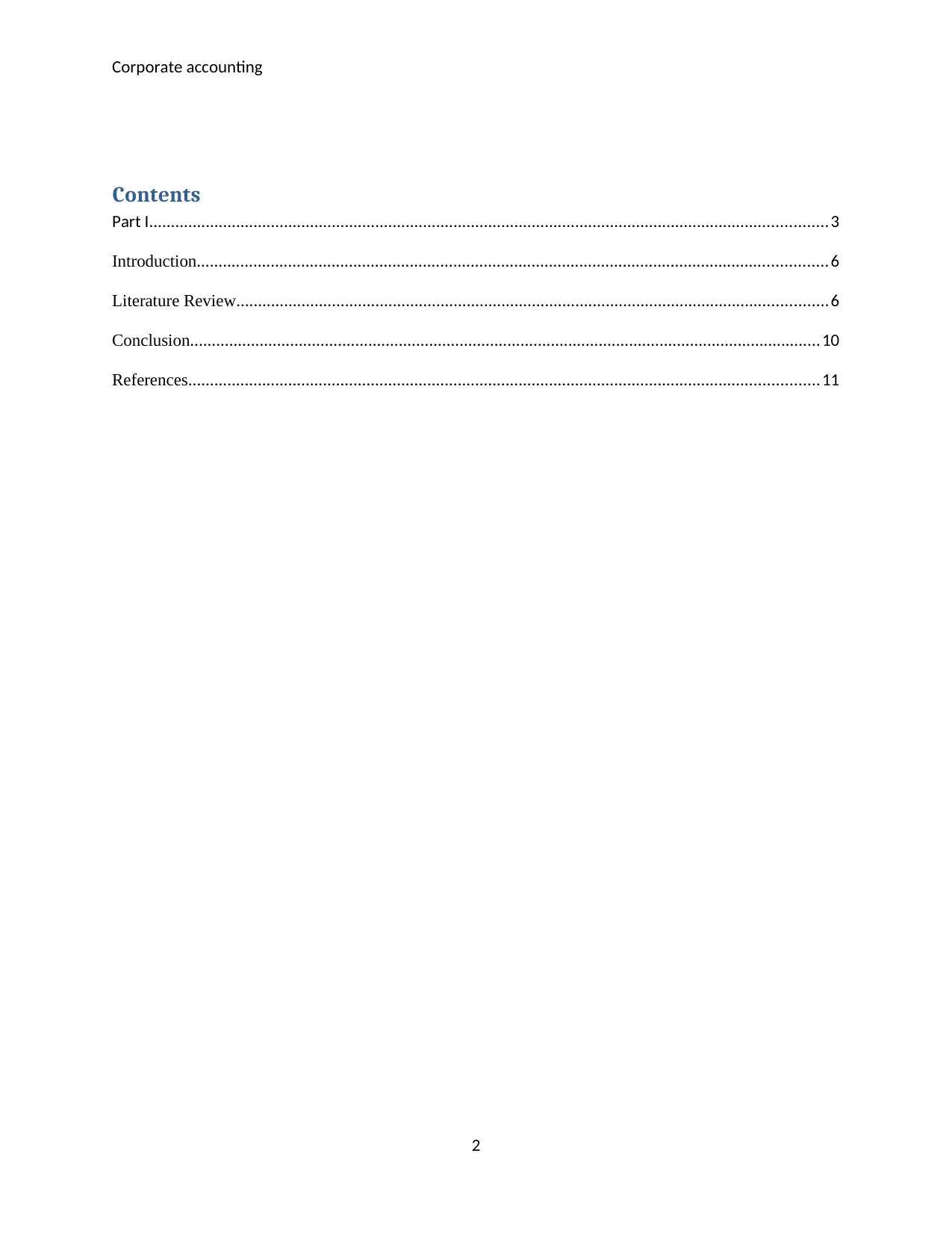
Corporate accounting
Contents
Part I............................................................................................................................................................3
Introduction.................................................................................................................................................6
Literature Review........................................................................................................................................6
Conclusion.................................................................................................................................................10
References.................................................................................................................................................11
2
Contents
Part I............................................................................................................................................................3
Introduction.................................................................................................................................................6
Literature Review........................................................................................................................................6
Conclusion.................................................................................................................................................10
References.................................................................................................................................................11
2
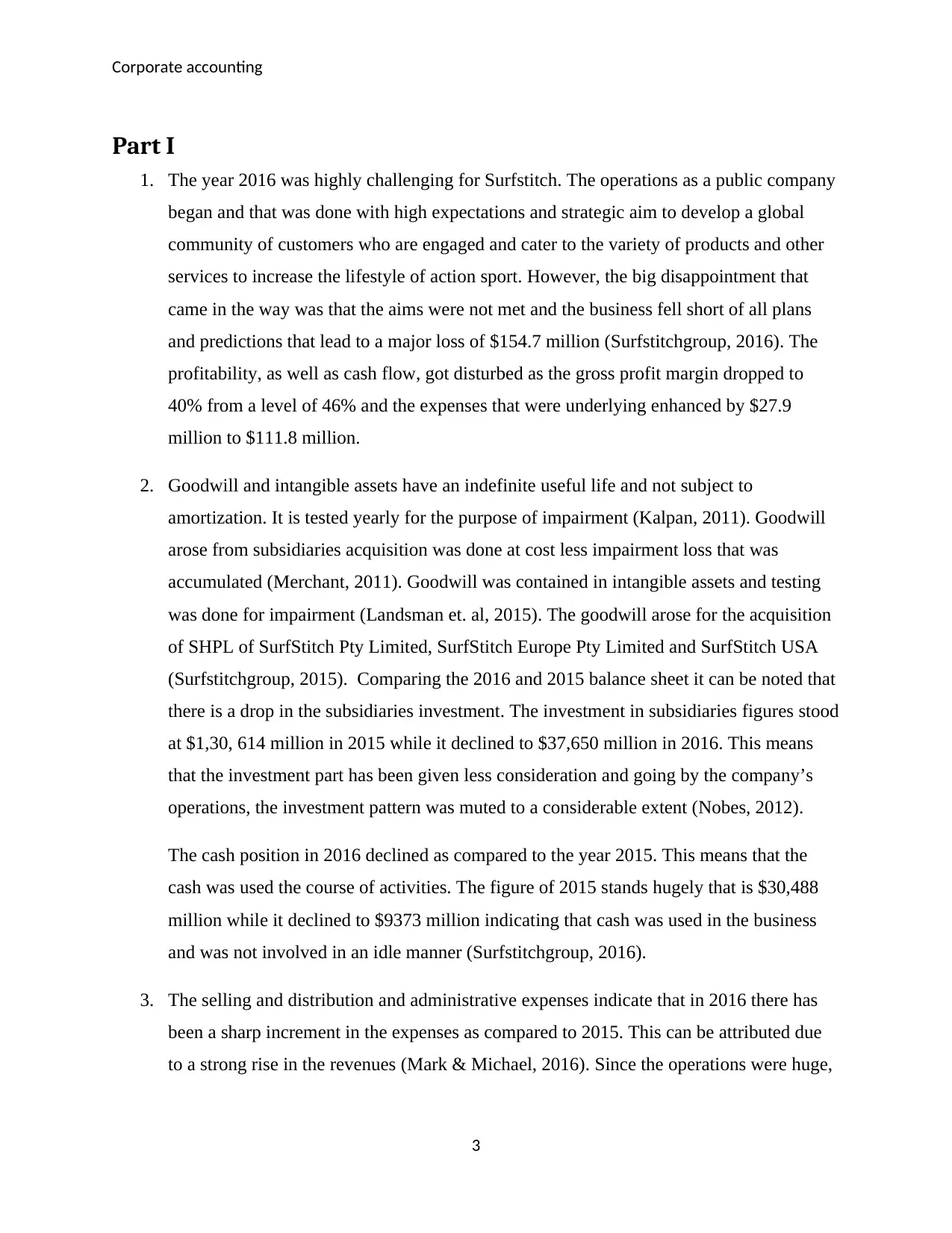
Corporate accounting
Part I
1. The year 2016 was highly challenging for Surfstitch. The operations as a public company
began and that was done with high expectations and strategic aim to develop a global
community of customers who are engaged and cater to the variety of products and other
services to increase the lifestyle of action sport. However, the big disappointment that
came in the way was that the aims were not met and the business fell short of all plans
and predictions that lead to a major loss of $154.7 million (Surfstitchgroup, 2016). The
profitability, as well as cash flow, got disturbed as the gross profit margin dropped to
40% from a level of 46% and the expenses that were underlying enhanced by $27.9
million to $111.8 million.
2. Goodwill and intangible assets have an indefinite useful life and not subject to
amortization. It is tested yearly for the purpose of impairment (Kalpan, 2011). Goodwill
arose from subsidiaries acquisition was done at cost less impairment loss that was
accumulated (Merchant, 2011). Goodwill was contained in intangible assets and testing
was done for impairment (Landsman et. al, 2015). The goodwill arose for the acquisition
of SHPL of SurfStitch Pty Limited, SurfStitch Europe Pty Limited and SurfStitch USA
(Surfstitchgroup, 2015). Comparing the 2016 and 2015 balance sheet it can be noted that
there is a drop in the subsidiaries investment. The investment in subsidiaries figures stood
at $1,30, 614 million in 2015 while it declined to $37,650 million in 2016. This means
that the investment part has been given less consideration and going by the company’s
operations, the investment pattern was muted to a considerable extent (Nobes, 2012).
The cash position in 2016 declined as compared to the year 2015. This means that the
cash was used the course of activities. The figure of 2015 stands hugely that is $30,488
million while it declined to $9373 million indicating that cash was used in the business
and was not involved in an idle manner (Surfstitchgroup, 2016).
3. The selling and distribution and administrative expenses indicate that in 2016 there has
been a sharp increment in the expenses as compared to 2015. This can be attributed due
to a strong rise in the revenues (Mark & Michael, 2016). Since the operations were huge,
3
Part I
1. The year 2016 was highly challenging for Surfstitch. The operations as a public company
began and that was done with high expectations and strategic aim to develop a global
community of customers who are engaged and cater to the variety of products and other
services to increase the lifestyle of action sport. However, the big disappointment that
came in the way was that the aims were not met and the business fell short of all plans
and predictions that lead to a major loss of $154.7 million (Surfstitchgroup, 2016). The
profitability, as well as cash flow, got disturbed as the gross profit margin dropped to
40% from a level of 46% and the expenses that were underlying enhanced by $27.9
million to $111.8 million.
2. Goodwill and intangible assets have an indefinite useful life and not subject to
amortization. It is tested yearly for the purpose of impairment (Kalpan, 2011). Goodwill
arose from subsidiaries acquisition was done at cost less impairment loss that was
accumulated (Merchant, 2011). Goodwill was contained in intangible assets and testing
was done for impairment (Landsman et. al, 2015). The goodwill arose for the acquisition
of SHPL of SurfStitch Pty Limited, SurfStitch Europe Pty Limited and SurfStitch USA
(Surfstitchgroup, 2015). Comparing the 2016 and 2015 balance sheet it can be noted that
there is a drop in the subsidiaries investment. The investment in subsidiaries figures stood
at $1,30, 614 million in 2015 while it declined to $37,650 million in 2016. This means
that the investment part has been given less consideration and going by the company’s
operations, the investment pattern was muted to a considerable extent (Nobes, 2012).
The cash position in 2016 declined as compared to the year 2015. This means that the
cash was used the course of activities. The figure of 2015 stands hugely that is $30,488
million while it declined to $9373 million indicating that cash was used in the business
and was not involved in an idle manner (Surfstitchgroup, 2016).
3. The selling and distribution and administrative expenses indicate that in 2016 there has
been a sharp increment in the expenses as compared to 2015. This can be attributed due
to a strong rise in the revenues (Mark & Michael, 2016). Since the operations were huge,
3
⊘ This is a preview!⊘
Do you want full access?
Subscribe today to unlock all pages.

Trusted by 1+ million students worldwide
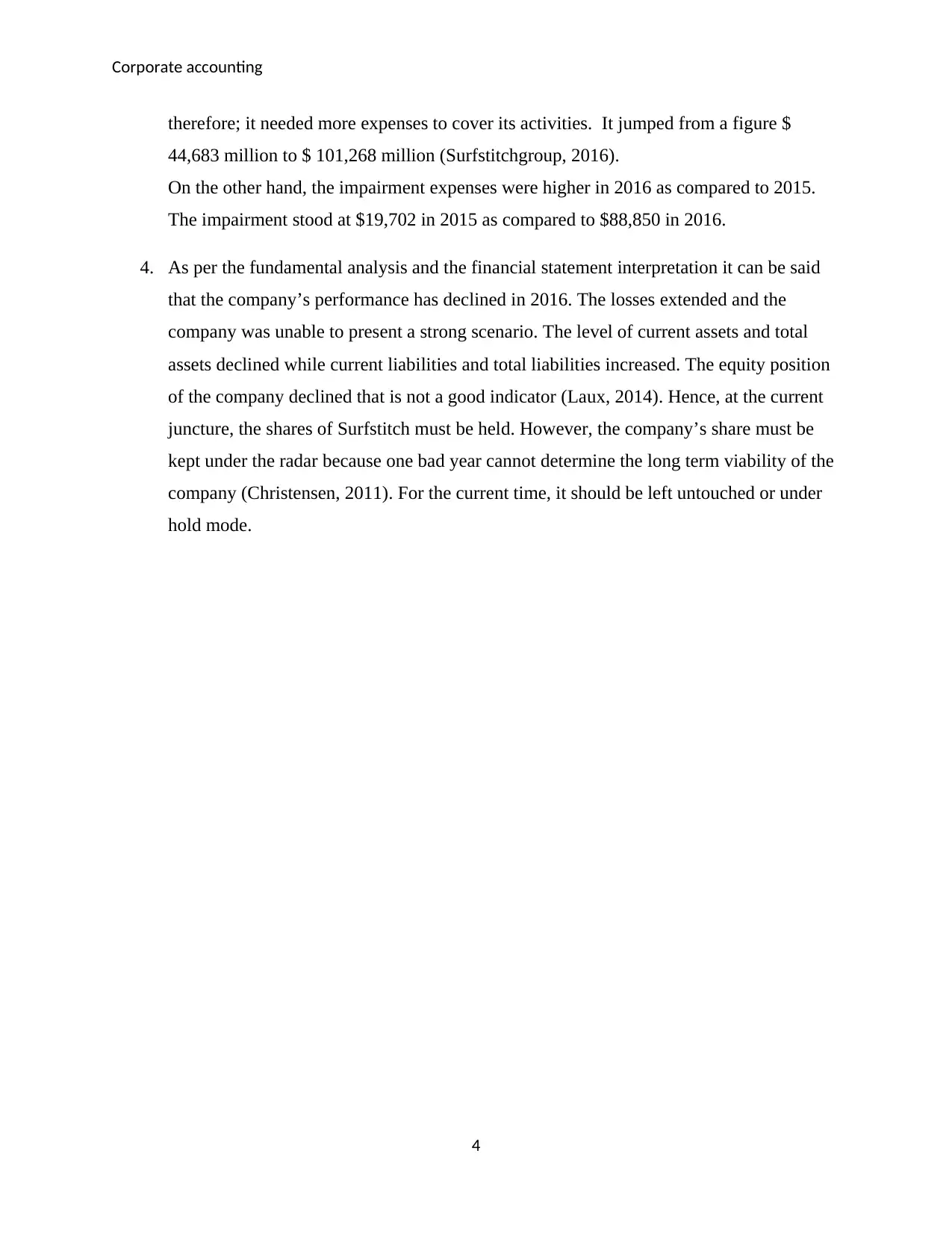
Corporate accounting
therefore; it needed more expenses to cover its activities. It jumped from a figure $
44,683 million to $ 101,268 million (Surfstitchgroup, 2016).
On the other hand, the impairment expenses were higher in 2016 as compared to 2015.
The impairment stood at $19,702 in 2015 as compared to $88,850 in 2016.
4. As per the fundamental analysis and the financial statement interpretation it can be said
that the company’s performance has declined in 2016. The losses extended and the
company was unable to present a strong scenario. The level of current assets and total
assets declined while current liabilities and total liabilities increased. The equity position
of the company declined that is not a good indicator (Laux, 2014). Hence, at the current
juncture, the shares of Surfstitch must be held. However, the company’s share must be
kept under the radar because one bad year cannot determine the long term viability of the
company (Christensen, 2011). For the current time, it should be left untouched or under
hold mode.
4
therefore; it needed more expenses to cover its activities. It jumped from a figure $
44,683 million to $ 101,268 million (Surfstitchgroup, 2016).
On the other hand, the impairment expenses were higher in 2016 as compared to 2015.
The impairment stood at $19,702 in 2015 as compared to $88,850 in 2016.
4. As per the fundamental analysis and the financial statement interpretation it can be said
that the company’s performance has declined in 2016. The losses extended and the
company was unable to present a strong scenario. The level of current assets and total
assets declined while current liabilities and total liabilities increased. The equity position
of the company declined that is not a good indicator (Laux, 2014). Hence, at the current
juncture, the shares of Surfstitch must be held. However, the company’s share must be
kept under the radar because one bad year cannot determine the long term viability of the
company (Christensen, 2011). For the current time, it should be left untouched or under
hold mode.
4
Paraphrase This Document
Need a fresh take? Get an instant paraphrase of this document with our AI Paraphraser
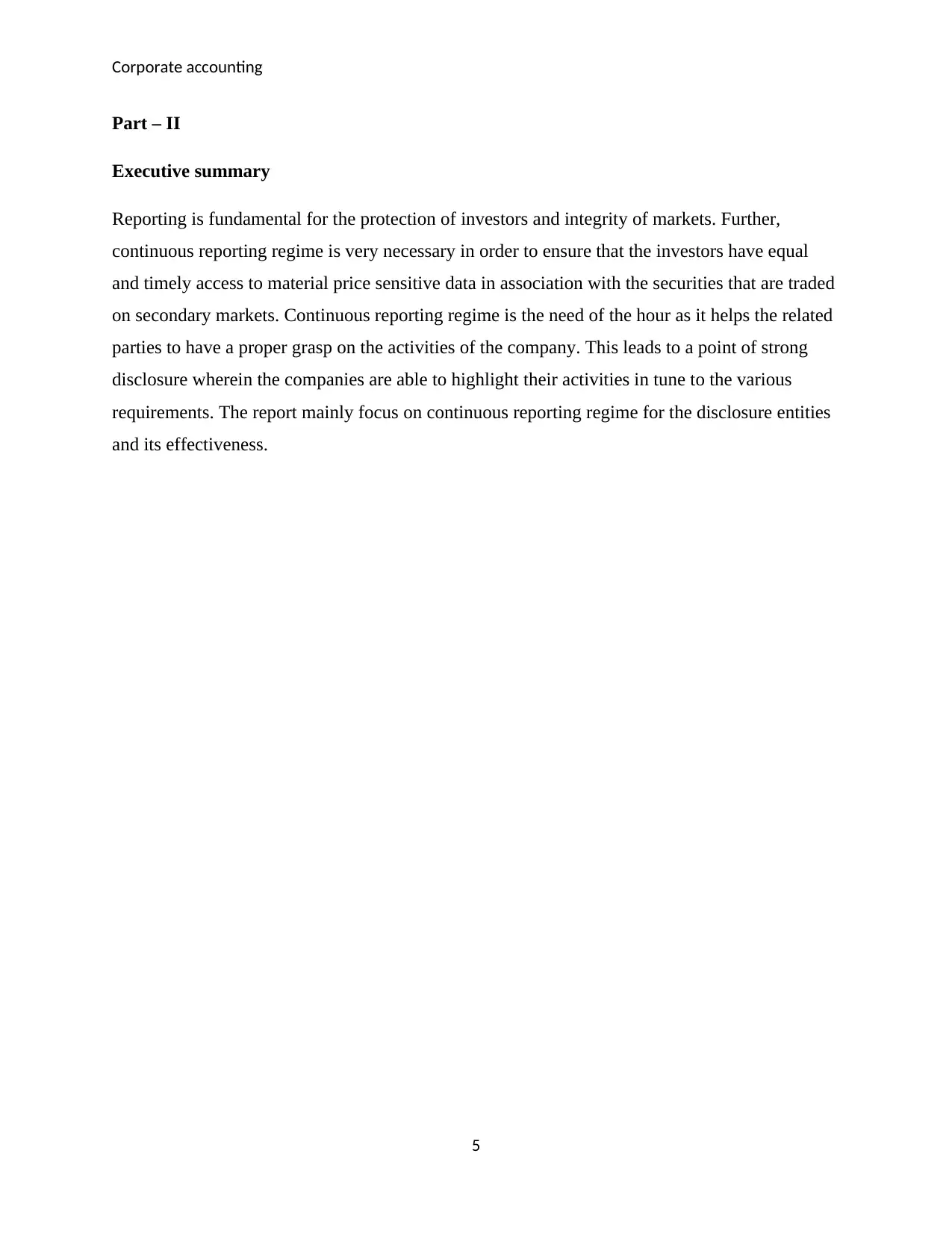
Corporate accounting
Part – II
Executive summary
Reporting is fundamental for the protection of investors and integrity of markets. Further,
continuous reporting regime is very necessary in order to ensure that the investors have equal
and timely access to material price sensitive data in association with the securities that are traded
on secondary markets. Continuous reporting regime is the need of the hour as it helps the related
parties to have a proper grasp on the activities of the company. This leads to a point of strong
disclosure wherein the companies are able to highlight their activities in tune to the various
requirements. The report mainly focus on continuous reporting regime for the disclosure entities
and its effectiveness.
5
Part – II
Executive summary
Reporting is fundamental for the protection of investors and integrity of markets. Further,
continuous reporting regime is very necessary in order to ensure that the investors have equal
and timely access to material price sensitive data in association with the securities that are traded
on secondary markets. Continuous reporting regime is the need of the hour as it helps the related
parties to have a proper grasp on the activities of the company. This leads to a point of strong
disclosure wherein the companies are able to highlight their activities in tune to the various
requirements. The report mainly focus on continuous reporting regime for the disclosure entities
and its effectiveness.
5
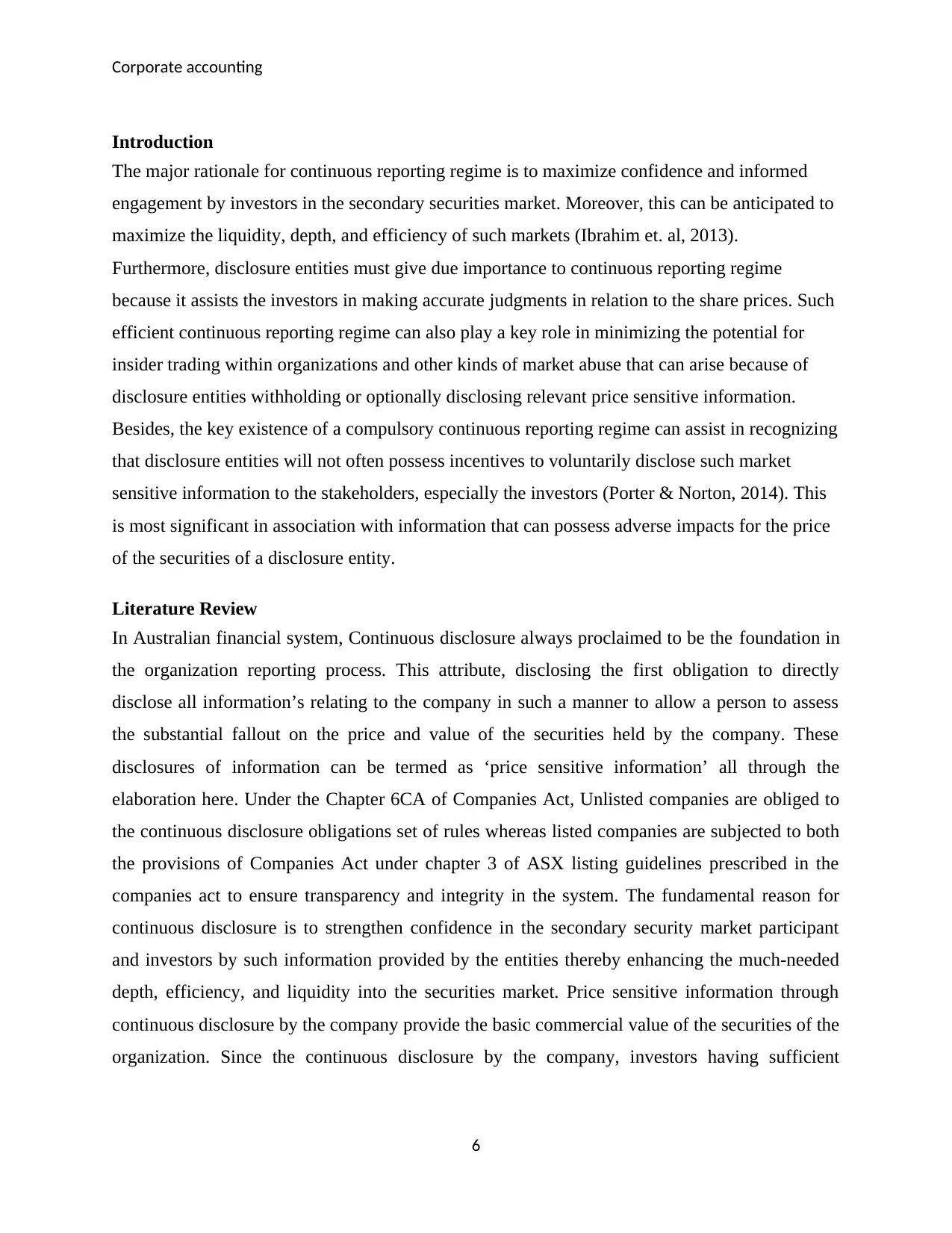
Corporate accounting
Introduction
The major rationale for continuous reporting regime is to maximize confidence and informed
engagement by investors in the secondary securities market. Moreover, this can be anticipated to
maximize the liquidity, depth, and efficiency of such markets (Ibrahim et. al, 2013).
Furthermore, disclosure entities must give due importance to continuous reporting regime
because it assists the investors in making accurate judgments in relation to the share prices. Such
efficient continuous reporting regime can also play a key role in minimizing the potential for
insider trading within organizations and other kinds of market abuse that can arise because of
disclosure entities withholding or optionally disclosing relevant price sensitive information.
Besides, the key existence of a compulsory continuous reporting regime can assist in recognizing
that disclosure entities will not often possess incentives to voluntarily disclose such market
sensitive information to the stakeholders, especially the investors (Porter & Norton, 2014). This
is most significant in association with information that can possess adverse impacts for the price
of the securities of a disclosure entity.
Literature Review
In Australian financial system, Continuous disclosure always proclaimed to be the foundation in
the organization reporting process. This attribute, disclosing the first obligation to directly
disclose all information’s relating to the company in such a manner to allow a person to assess
the substantial fallout on the price and value of the securities held by the company. These
disclosures of information can be termed as ‘price sensitive information’ all through the
elaboration here. Under the Chapter 6CA of Companies Act, Unlisted companies are obliged to
the continuous disclosure obligations set of rules whereas listed companies are subjected to both
the provisions of Companies Act under chapter 3 of ASX listing guidelines prescribed in the
companies act to ensure transparency and integrity in the system. The fundamental reason for
continuous disclosure is to strengthen confidence in the secondary security market participant
and investors by such information provided by the entities thereby enhancing the much-needed
depth, efficiency, and liquidity into the securities market. Price sensitive information through
continuous disclosure by the company provide the basic commercial value of the securities of the
organization. Since the continuous disclosure by the company, investors having sufficient
6
Introduction
The major rationale for continuous reporting regime is to maximize confidence and informed
engagement by investors in the secondary securities market. Moreover, this can be anticipated to
maximize the liquidity, depth, and efficiency of such markets (Ibrahim et. al, 2013).
Furthermore, disclosure entities must give due importance to continuous reporting regime
because it assists the investors in making accurate judgments in relation to the share prices. Such
efficient continuous reporting regime can also play a key role in minimizing the potential for
insider trading within organizations and other kinds of market abuse that can arise because of
disclosure entities withholding or optionally disclosing relevant price sensitive information.
Besides, the key existence of a compulsory continuous reporting regime can assist in recognizing
that disclosure entities will not often possess incentives to voluntarily disclose such market
sensitive information to the stakeholders, especially the investors (Porter & Norton, 2014). This
is most significant in association with information that can possess adverse impacts for the price
of the securities of a disclosure entity.
Literature Review
In Australian financial system, Continuous disclosure always proclaimed to be the foundation in
the organization reporting process. This attribute, disclosing the first obligation to directly
disclose all information’s relating to the company in such a manner to allow a person to assess
the substantial fallout on the price and value of the securities held by the company. These
disclosures of information can be termed as ‘price sensitive information’ all through the
elaboration here. Under the Chapter 6CA of Companies Act, Unlisted companies are obliged to
the continuous disclosure obligations set of rules whereas listed companies are subjected to both
the provisions of Companies Act under chapter 3 of ASX listing guidelines prescribed in the
companies act to ensure transparency and integrity in the system. The fundamental reason for
continuous disclosure is to strengthen confidence in the secondary security market participant
and investors by such information provided by the entities thereby enhancing the much-needed
depth, efficiency, and liquidity into the securities market. Price sensitive information through
continuous disclosure by the company provide the basic commercial value of the securities of the
organization. Since the continuous disclosure by the company, investors having sufficient
6
⊘ This is a preview!⊘
Do you want full access?
Subscribe today to unlock all pages.

Trusted by 1+ million students worldwide
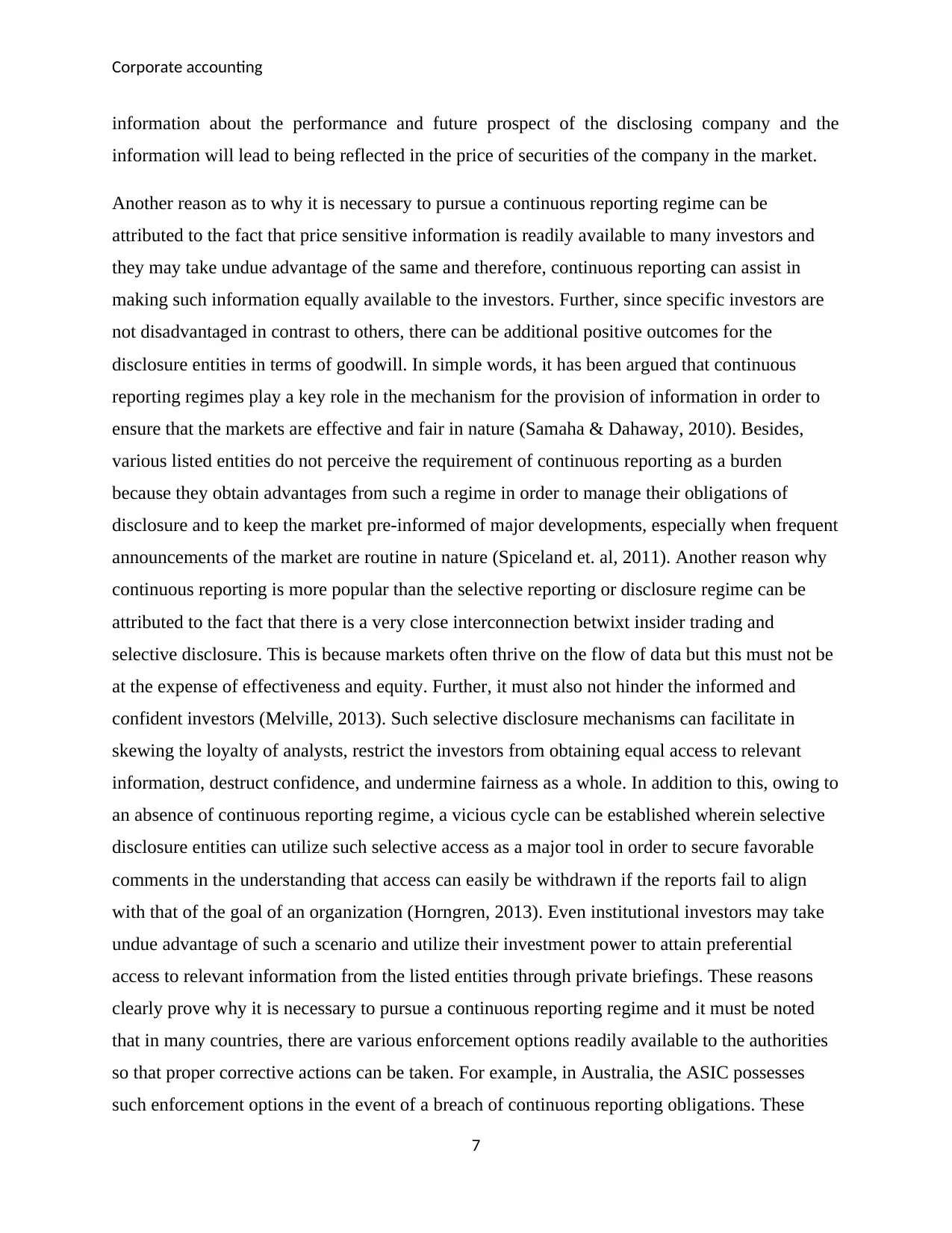
Corporate accounting
information about the performance and future prospect of the disclosing company and the
information will lead to being reflected in the price of securities of the company in the market.
Another reason as to why it is necessary to pursue a continuous reporting regime can be
attributed to the fact that price sensitive information is readily available to many investors and
they may take undue advantage of the same and therefore, continuous reporting can assist in
making such information equally available to the investors. Further, since specific investors are
not disadvantaged in contrast to others, there can be additional positive outcomes for the
disclosure entities in terms of goodwill. In simple words, it has been argued that continuous
reporting regimes play a key role in the mechanism for the provision of information in order to
ensure that the markets are effective and fair in nature (Samaha & Dahaway, 2010). Besides,
various listed entities do not perceive the requirement of continuous reporting as a burden
because they obtain advantages from such a regime in order to manage their obligations of
disclosure and to keep the market pre-informed of major developments, especially when frequent
announcements of the market are routine in nature (Spiceland et. al, 2011). Another reason why
continuous reporting is more popular than the selective reporting or disclosure regime can be
attributed to the fact that there is a very close interconnection betwixt insider trading and
selective disclosure. This is because markets often thrive on the flow of data but this must not be
at the expense of effectiveness and equity. Further, it must also not hinder the informed and
confident investors (Melville, 2013). Such selective disclosure mechanisms can facilitate in
skewing the loyalty of analysts, restrict the investors from obtaining equal access to relevant
information, destruct confidence, and undermine fairness as a whole. In addition to this, owing to
an absence of continuous reporting regime, a vicious cycle can be established wherein selective
disclosure entities can utilize such selective access as a major tool in order to secure favorable
comments in the understanding that access can easily be withdrawn if the reports fail to align
with that of the goal of an organization (Horngren, 2013). Even institutional investors may take
undue advantage of such a scenario and utilize their investment power to attain preferential
access to relevant information from the listed entities through private briefings. These reasons
clearly prove why it is necessary to pursue a continuous reporting regime and it must be noted
that in many countries, there are various enforcement options readily available to the authorities
so that proper corrective actions can be taken. For example, in Australia, the ASIC possesses
such enforcement options in the event of a breach of continuous reporting obligations. These
7
information about the performance and future prospect of the disclosing company and the
information will lead to being reflected in the price of securities of the company in the market.
Another reason as to why it is necessary to pursue a continuous reporting regime can be
attributed to the fact that price sensitive information is readily available to many investors and
they may take undue advantage of the same and therefore, continuous reporting can assist in
making such information equally available to the investors. Further, since specific investors are
not disadvantaged in contrast to others, there can be additional positive outcomes for the
disclosure entities in terms of goodwill. In simple words, it has been argued that continuous
reporting regimes play a key role in the mechanism for the provision of information in order to
ensure that the markets are effective and fair in nature (Samaha & Dahaway, 2010). Besides,
various listed entities do not perceive the requirement of continuous reporting as a burden
because they obtain advantages from such a regime in order to manage their obligations of
disclosure and to keep the market pre-informed of major developments, especially when frequent
announcements of the market are routine in nature (Spiceland et. al, 2011). Another reason why
continuous reporting is more popular than the selective reporting or disclosure regime can be
attributed to the fact that there is a very close interconnection betwixt insider trading and
selective disclosure. This is because markets often thrive on the flow of data but this must not be
at the expense of effectiveness and equity. Further, it must also not hinder the informed and
confident investors (Melville, 2013). Such selective disclosure mechanisms can facilitate in
skewing the loyalty of analysts, restrict the investors from obtaining equal access to relevant
information, destruct confidence, and undermine fairness as a whole. In addition to this, owing to
an absence of continuous reporting regime, a vicious cycle can be established wherein selective
disclosure entities can utilize such selective access as a major tool in order to secure favorable
comments in the understanding that access can easily be withdrawn if the reports fail to align
with that of the goal of an organization (Horngren, 2013). Even institutional investors may take
undue advantage of such a scenario and utilize their investment power to attain preferential
access to relevant information from the listed entities through private briefings. These reasons
clearly prove why it is necessary to pursue a continuous reporting regime and it must be noted
that in many countries, there are various enforcement options readily available to the authorities
so that proper corrective actions can be taken. For example, in Australia, the ASIC possesses
such enforcement options in the event of a breach of continuous reporting obligations. These
7
Paraphrase This Document
Need a fresh take? Get an instant paraphrase of this document with our AI Paraphraser
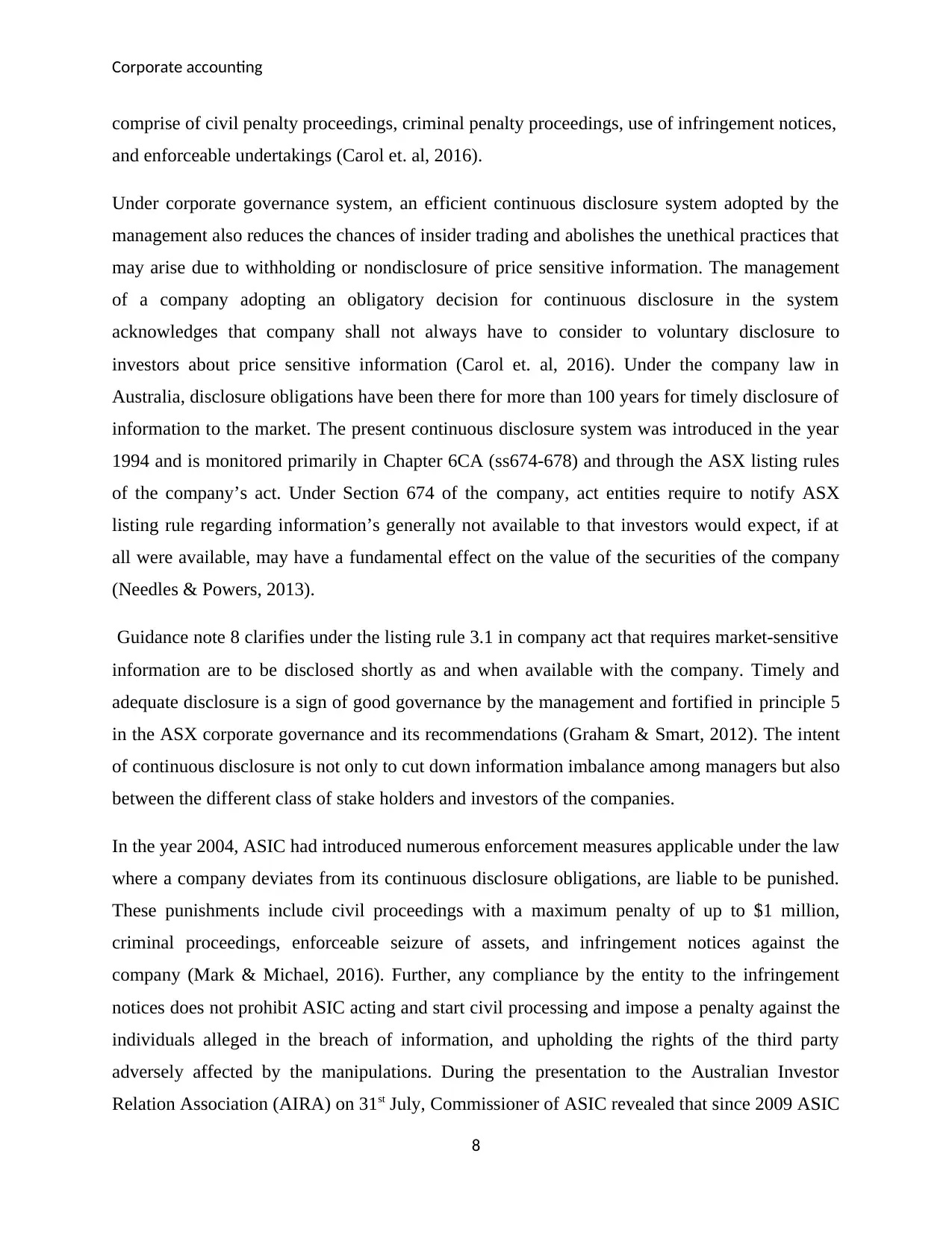
Corporate accounting
comprise of civil penalty proceedings, criminal penalty proceedings, use of infringement notices,
and enforceable undertakings (Carol et. al, 2016).
Under corporate governance system, an efficient continuous disclosure system adopted by the
management also reduces the chances of insider trading and abolishes the unethical practices that
may arise due to withholding or nondisclosure of price sensitive information. The management
of a company adopting an obligatory decision for continuous disclosure in the system
acknowledges that company shall not always have to consider to voluntary disclosure to
investors about price sensitive information (Carol et. al, 2016). Under the company law in
Australia, disclosure obligations have been there for more than 100 years for timely disclosure of
information to the market. The present continuous disclosure system was introduced in the year
1994 and is monitored primarily in Chapter 6CA (ss674-678) and through the ASX listing rules
of the company’s act. Under Section 674 of the company, act entities require to notify ASX
listing rule regarding information’s generally not available to that investors would expect, if at
all were available, may have a fundamental effect on the value of the securities of the company
(Needles & Powers, 2013).
Guidance note 8 clarifies under the listing rule 3.1 in company act that requires market-sensitive
information are to be disclosed shortly as and when available with the company. Timely and
adequate disclosure is a sign of good governance by the management and fortified in principle 5
in the ASX corporate governance and its recommendations (Graham & Smart, 2012). The intent
of continuous disclosure is not only to cut down information imbalance among managers but also
between the different class of stake holders and investors of the companies.
In the year 2004, ASIC had introduced numerous enforcement measures applicable under the law
where a company deviates from its continuous disclosure obligations, are liable to be punished.
These punishments include civil proceedings with a maximum penalty of up to $1 million,
criminal proceedings, enforceable seizure of assets, and infringement notices against the
company (Mark & Michael, 2016). Further, any compliance by the entity to the infringement
notices does not prohibit ASIC acting and start civil processing and impose a penalty against the
individuals alleged in the breach of information, and upholding the rights of the third party
adversely affected by the manipulations. During the presentation to the Australian Investor
Relation Association (AIRA) on 31st July, Commissioner of ASIC revealed that since 2009 ASIC
8
comprise of civil penalty proceedings, criminal penalty proceedings, use of infringement notices,
and enforceable undertakings (Carol et. al, 2016).
Under corporate governance system, an efficient continuous disclosure system adopted by the
management also reduces the chances of insider trading and abolishes the unethical practices that
may arise due to withholding or nondisclosure of price sensitive information. The management
of a company adopting an obligatory decision for continuous disclosure in the system
acknowledges that company shall not always have to consider to voluntary disclosure to
investors about price sensitive information (Carol et. al, 2016). Under the company law in
Australia, disclosure obligations have been there for more than 100 years for timely disclosure of
information to the market. The present continuous disclosure system was introduced in the year
1994 and is monitored primarily in Chapter 6CA (ss674-678) and through the ASX listing rules
of the company’s act. Under Section 674 of the company, act entities require to notify ASX
listing rule regarding information’s generally not available to that investors would expect, if at
all were available, may have a fundamental effect on the value of the securities of the company
(Needles & Powers, 2013).
Guidance note 8 clarifies under the listing rule 3.1 in company act that requires market-sensitive
information are to be disclosed shortly as and when available with the company. Timely and
adequate disclosure is a sign of good governance by the management and fortified in principle 5
in the ASX corporate governance and its recommendations (Graham & Smart, 2012). The intent
of continuous disclosure is not only to cut down information imbalance among managers but also
between the different class of stake holders and investors of the companies.
In the year 2004, ASIC had introduced numerous enforcement measures applicable under the law
where a company deviates from its continuous disclosure obligations, are liable to be punished.
These punishments include civil proceedings with a maximum penalty of up to $1 million,
criminal proceedings, enforceable seizure of assets, and infringement notices against the
company (Mark & Michael, 2016). Further, any compliance by the entity to the infringement
notices does not prohibit ASIC acting and start civil processing and impose a penalty against the
individuals alleged in the breach of information, and upholding the rights of the third party
adversely affected by the manipulations. During the presentation to the Australian Investor
Relation Association (AIRA) on 31st July, Commissioner of ASIC revealed that since 2009 ASIC
8
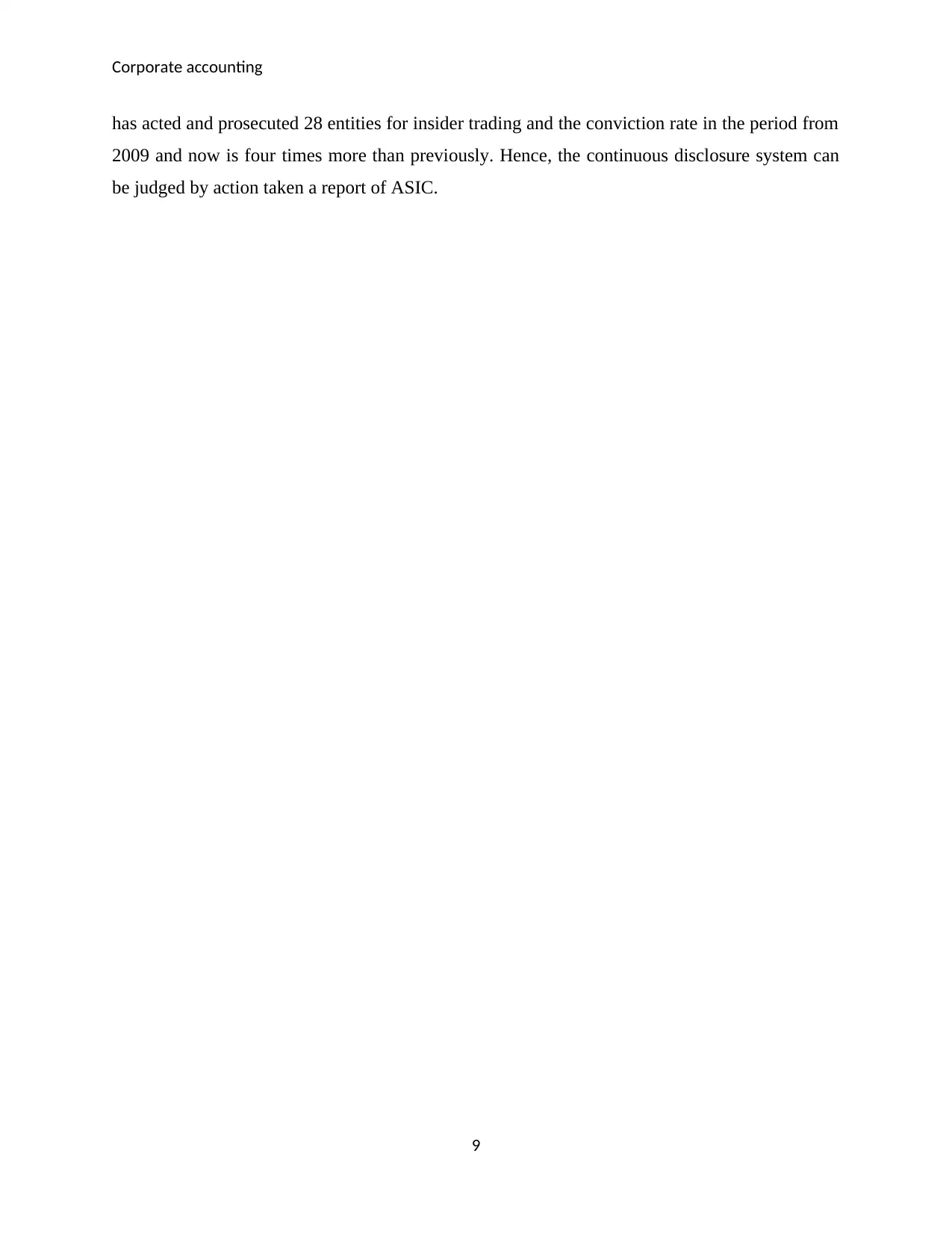
Corporate accounting
has acted and prosecuted 28 entities for insider trading and the conviction rate in the period from
2009 and now is four times more than previously. Hence, the continuous disclosure system can
be judged by action taken a report of ASIC.
9
has acted and prosecuted 28 entities for insider trading and the conviction rate in the period from
2009 and now is four times more than previously. Hence, the continuous disclosure system can
be judged by action taken a report of ASIC.
9
⊘ This is a preview!⊘
Do you want full access?
Subscribe today to unlock all pages.

Trusted by 1+ million students worldwide
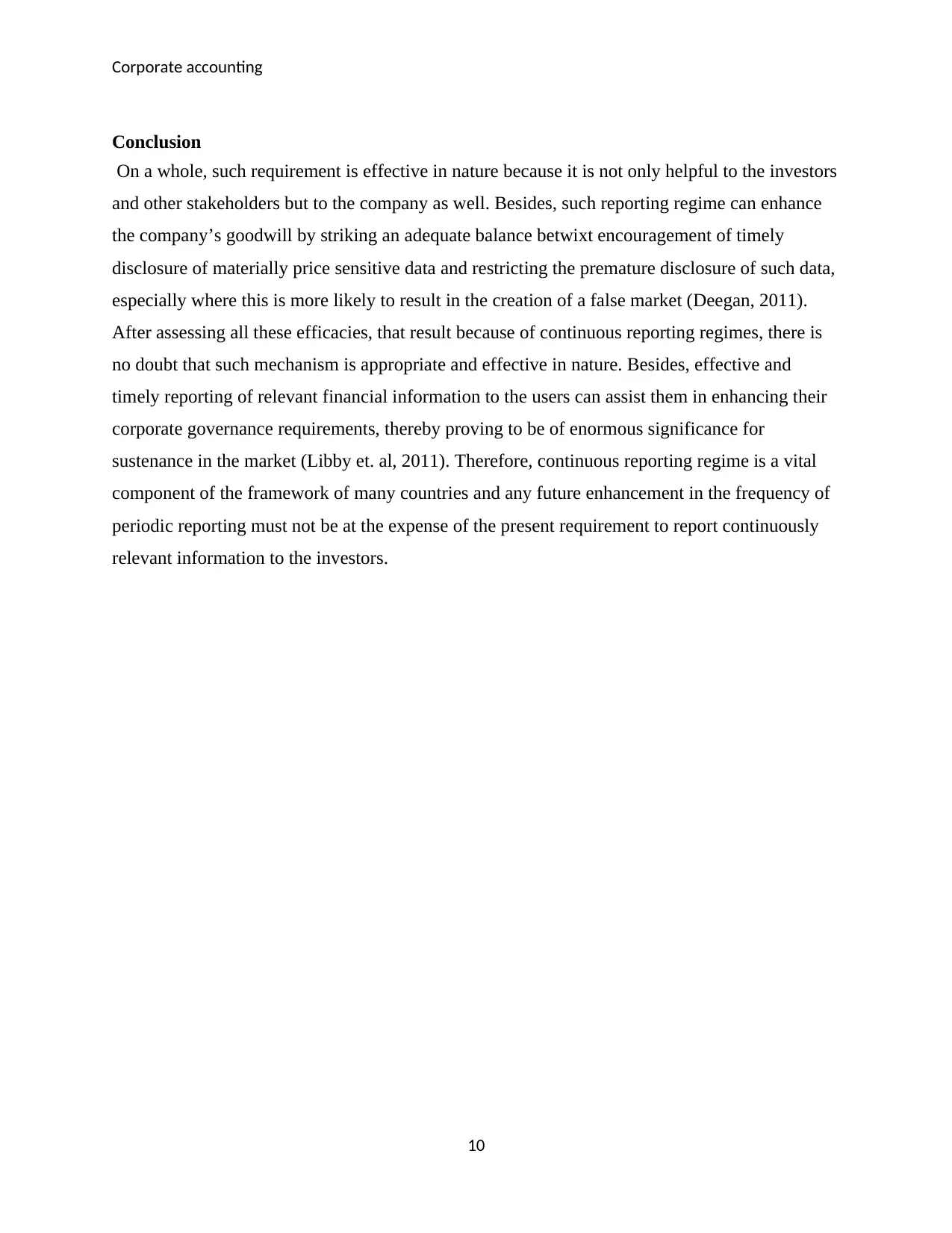
Corporate accounting
Conclusion
On a whole, such requirement is effective in nature because it is not only helpful to the investors
and other stakeholders but to the company as well. Besides, such reporting regime can enhance
the company’s goodwill by striking an adequate balance betwixt encouragement of timely
disclosure of materially price sensitive data and restricting the premature disclosure of such data,
especially where this is more likely to result in the creation of a false market (Deegan, 2011).
After assessing all these efficacies, that result because of continuous reporting regimes, there is
no doubt that such mechanism is appropriate and effective in nature. Besides, effective and
timely reporting of relevant financial information to the users can assist them in enhancing their
corporate governance requirements, thereby proving to be of enormous significance for
sustenance in the market (Libby et. al, 2011). Therefore, continuous reporting regime is a vital
component of the framework of many countries and any future enhancement in the frequency of
periodic reporting must not be at the expense of the present requirement to report continuously
relevant information to the investors.
10
Conclusion
On a whole, such requirement is effective in nature because it is not only helpful to the investors
and other stakeholders but to the company as well. Besides, such reporting regime can enhance
the company’s goodwill by striking an adequate balance betwixt encouragement of timely
disclosure of materially price sensitive data and restricting the premature disclosure of such data,
especially where this is more likely to result in the creation of a false market (Deegan, 2011).
After assessing all these efficacies, that result because of continuous reporting regimes, there is
no doubt that such mechanism is appropriate and effective in nature. Besides, effective and
timely reporting of relevant financial information to the users can assist them in enhancing their
corporate governance requirements, thereby proving to be of enormous significance for
sustenance in the market (Libby et. al, 2011). Therefore, continuous reporting regime is a vital
component of the framework of many countries and any future enhancement in the frequency of
periodic reporting must not be at the expense of the present requirement to report continuously
relevant information to the investors.
10
Paraphrase This Document
Need a fresh take? Get an instant paraphrase of this document with our AI Paraphraser
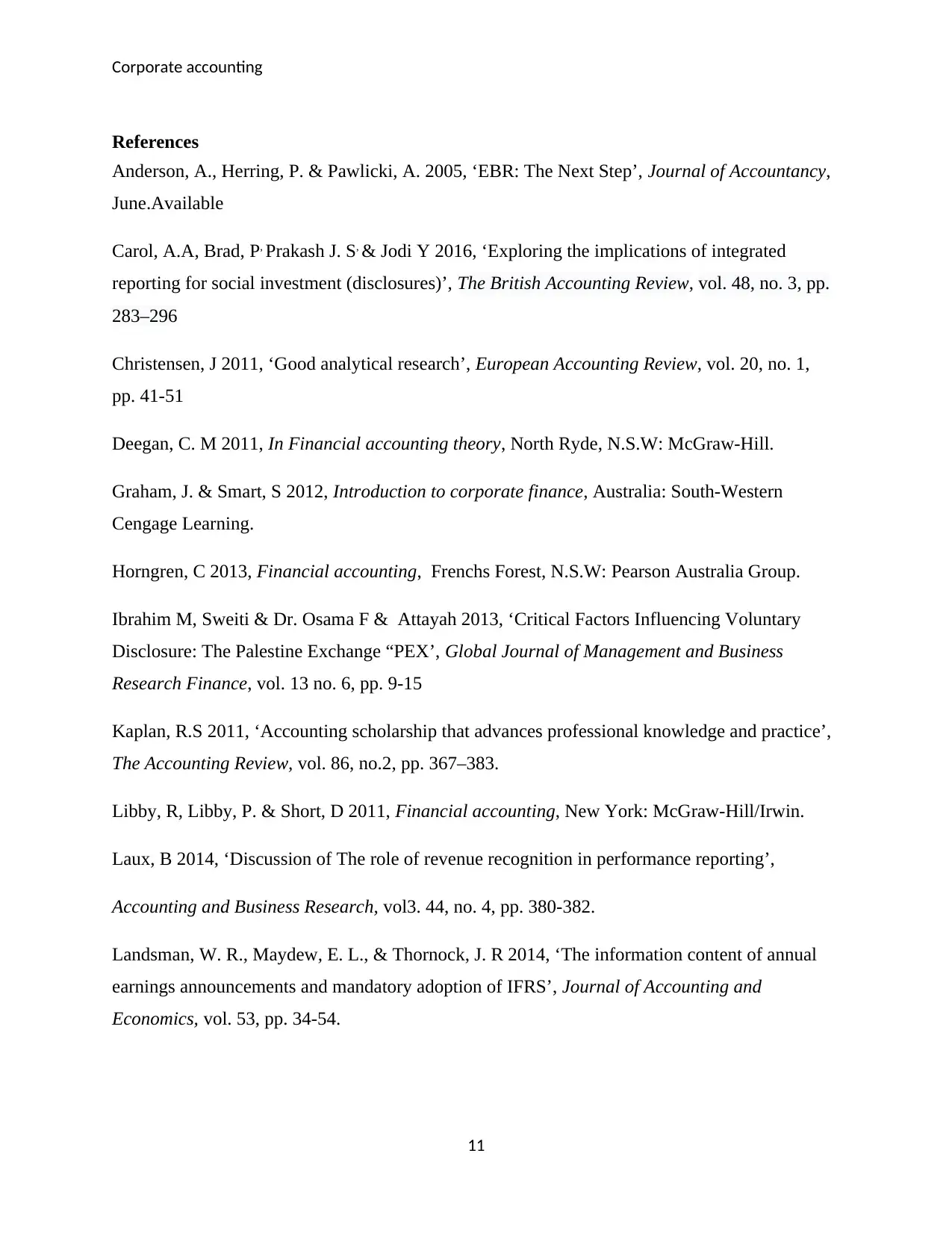
Corporate accounting
References
Anderson, A., Herring, P. & Pawlicki, A. 2005, ‘EBR: The Next Step’, Journal of Accountancy,
June.Available
Carol, A.A, Brad, P, Prakash J. S, & Jodi Y 2016, ‘Exploring the implications of integrated
reporting for social investment (disclosures)’, The British Accounting Review, vol. 48, no. 3, pp.
283–296
Christensen, J 2011, ‘Good analytical research’, European Accounting Review, vol. 20, no. 1,
pp. 41-51
Deegan, C. M 2011, In Financial accounting theory, North Ryde, N.S.W: McGraw-Hill.
Graham, J. & Smart, S 2012, Introduction to corporate finance, Australia: South-Western
Cengage Learning.
Horngren, C 2013, Financial accounting, Frenchs Forest, N.S.W: Pearson Australia Group.
Ibrahim M, Sweiti & Dr. Osama F & Attayah 2013, ‘Critical Factors Influencing Voluntary
Disclosure: The Palestine Exchange “PEX’, Global Journal of Management and Business
Research Finance, vol. 13 no. 6, pp. 9-15
Kaplan, R.S 2011, ‘Accounting scholarship that advances professional knowledge and practice’,
The Accounting Review, vol. 86, no.2, pp. 367–383.
Libby, R, Libby, P. & Short, D 2011, Financial accounting, New York: McGraw-Hill/Irwin.
Laux, B 2014, ‘Discussion of The role of revenue recognition in performance reporting’,
Accounting and Business Research, vol3. 44, no. 4, pp. 380-382.
Landsman, W. R., Maydew, E. L., & Thornock, J. R 2014, ‘The information content of annual
earnings announcements and mandatory adoption of IFRS’, Journal of Accounting and
Economics, vol. 53, pp. 34-54.
11
References
Anderson, A., Herring, P. & Pawlicki, A. 2005, ‘EBR: The Next Step’, Journal of Accountancy,
June.Available
Carol, A.A, Brad, P, Prakash J. S, & Jodi Y 2016, ‘Exploring the implications of integrated
reporting for social investment (disclosures)’, The British Accounting Review, vol. 48, no. 3, pp.
283–296
Christensen, J 2011, ‘Good analytical research’, European Accounting Review, vol. 20, no. 1,
pp. 41-51
Deegan, C. M 2011, In Financial accounting theory, North Ryde, N.S.W: McGraw-Hill.
Graham, J. & Smart, S 2012, Introduction to corporate finance, Australia: South-Western
Cengage Learning.
Horngren, C 2013, Financial accounting, Frenchs Forest, N.S.W: Pearson Australia Group.
Ibrahim M, Sweiti & Dr. Osama F & Attayah 2013, ‘Critical Factors Influencing Voluntary
Disclosure: The Palestine Exchange “PEX’, Global Journal of Management and Business
Research Finance, vol. 13 no. 6, pp. 9-15
Kaplan, R.S 2011, ‘Accounting scholarship that advances professional knowledge and practice’,
The Accounting Review, vol. 86, no.2, pp. 367–383.
Libby, R, Libby, P. & Short, D 2011, Financial accounting, New York: McGraw-Hill/Irwin.
Laux, B 2014, ‘Discussion of The role of revenue recognition in performance reporting’,
Accounting and Business Research, vol3. 44, no. 4, pp. 380-382.
Landsman, W. R., Maydew, E. L., & Thornock, J. R 2014, ‘The information content of annual
earnings announcements and mandatory adoption of IFRS’, Journal of Accounting and
Economics, vol. 53, pp. 34-54.
11
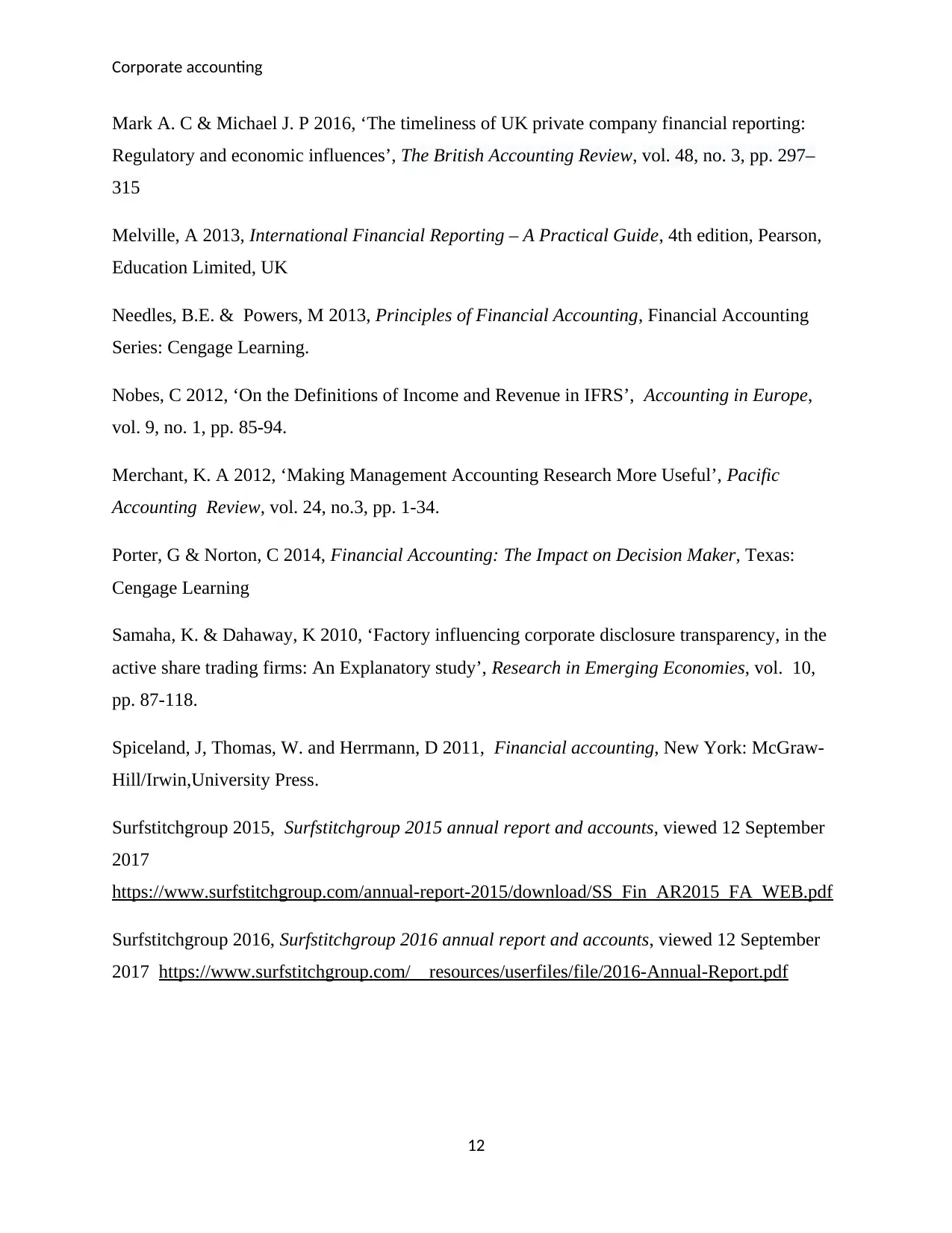
Corporate accounting
Mark A. C & Michael J. P 2016, ‘The timeliness of UK private company financial reporting:
Regulatory and economic influences’, The British Accounting Review, vol. 48, no. 3, pp. 297–
315
Melville, A 2013, International Financial Reporting – A Practical Guide, 4th edition, Pearson,
Education Limited, UK
Needles, B.E. & Powers, M 2013, Principles of Financial Accounting, Financial Accounting
Series: Cengage Learning.
Nobes, C 2012, ‘On the Definitions of Income and Revenue in IFRS’, Accounting in Europe,
vol. 9, no. 1, pp. 85-94.
Merchant, K. A 2012, ‘Making Management Accounting Research More Useful’, Pacific
Accounting Review, vol. 24, no.3, pp. 1-34.
Porter, G & Norton, C 2014, Financial Accounting: The Impact on Decision Maker, Texas:
Cengage Learning
Samaha, K. & Dahaway, K 2010, ‘Factory influencing corporate disclosure transparency, in the
active share trading firms: An Explanatory study’, Research in Emerging Economies, vol. 10,
pp. 87-118.
Spiceland, J, Thomas, W. and Herrmann, D 2011, Financial accounting, New York: McGraw-
Hill/Irwin,University Press.
Surfstitchgroup 2015, Surfstitchgroup 2015 annual report and accounts, viewed 12 September
2017
https://www.surfstitchgroup.com/annual-report-2015/download/SS_Fin_AR2015_FA_WEB.pdf
Surfstitchgroup 2016, Surfstitchgroup 2016 annual report and accounts, viewed 12 September
2017 https://www.surfstitchgroup.com/__resources/userfiles/file/2016-Annual-Report.pdf
12
Mark A. C & Michael J. P 2016, ‘The timeliness of UK private company financial reporting:
Regulatory and economic influences’, The British Accounting Review, vol. 48, no. 3, pp. 297–
315
Melville, A 2013, International Financial Reporting – A Practical Guide, 4th edition, Pearson,
Education Limited, UK
Needles, B.E. & Powers, M 2013, Principles of Financial Accounting, Financial Accounting
Series: Cengage Learning.
Nobes, C 2012, ‘On the Definitions of Income and Revenue in IFRS’, Accounting in Europe,
vol. 9, no. 1, pp. 85-94.
Merchant, K. A 2012, ‘Making Management Accounting Research More Useful’, Pacific
Accounting Review, vol. 24, no.3, pp. 1-34.
Porter, G & Norton, C 2014, Financial Accounting: The Impact on Decision Maker, Texas:
Cengage Learning
Samaha, K. & Dahaway, K 2010, ‘Factory influencing corporate disclosure transparency, in the
active share trading firms: An Explanatory study’, Research in Emerging Economies, vol. 10,
pp. 87-118.
Spiceland, J, Thomas, W. and Herrmann, D 2011, Financial accounting, New York: McGraw-
Hill/Irwin,University Press.
Surfstitchgroup 2015, Surfstitchgroup 2015 annual report and accounts, viewed 12 September
2017
https://www.surfstitchgroup.com/annual-report-2015/download/SS_Fin_AR2015_FA_WEB.pdf
Surfstitchgroup 2016, Surfstitchgroup 2016 annual report and accounts, viewed 12 September
2017 https://www.surfstitchgroup.com/__resources/userfiles/file/2016-Annual-Report.pdf
12
⊘ This is a preview!⊘
Do you want full access?
Subscribe today to unlock all pages.

Trusted by 1+ million students worldwide
1 out of 12
Related Documents
Your All-in-One AI-Powered Toolkit for Academic Success.
+13062052269
info@desklib.com
Available 24*7 on WhatsApp / Email
![[object Object]](/_next/static/media/star-bottom.7253800d.svg)
Unlock your academic potential
Copyright © 2020–2025 A2Z Services. All Rights Reserved. Developed and managed by ZUCOL.





